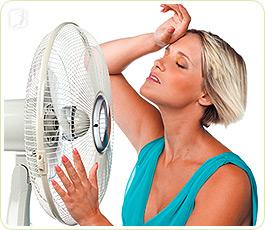
According to the North American Menopause Society, “The most common menopause-related discomfort is the hot flash (sometimes called a hot flush). Although their exact cause is still a matter of speculation, hot flashes are thought to be the result of changes in the hypothalamus, the part of the brain that regulates the body’s temperature. If the hypothalamus mistakenly senses that a woman is too warm, it starts a chain of events to cool her down. Blood vessels near the surface of the skin begin to dilate (enlarge), increasing blood flow to the surface in an attempt to dissipate body heat. This produces a red, flushed look to the face and neck in light-skinned women. It may also make a woman perspire to cool the body down. An increased pulse rate and a sensation of rapid heart beating may also occur. Hot flashes are often followed by a cold chill. A few women experience only the chill.”
Although the precise cause of hot flashes is still unknown, signs and symptoms show that estrogen reduction during menopause may disrupt hypothalamic function leading to hot flashes. Depending on the person, hot flashes may occur a few times a week or several times a day. Hot flashes that occur at night (night sweats) can interrupt your sleep cause other conditions.
According to the Mayo Clinic, not all women who go through menopause experience hot flashes. Although it’s not clear why some women get hot flashes and others don’t, the following factors increase your risk of hot flashes:
- Smoking. Women who smoke are more likely to get hot flashes.
- Obesity. A high body mass index (BMI) is associated with a higher frequency of hot flashes.
- Physical inactivity. If you don’t exercise, you’re more likely to have hot flashes during menopause.
- Ethnicity. More African-American women report menopausal hot flashes than do women of European descent. Hot flashes are less common in women of Japanese and Chinese descent than in white European women.
Women with low, as well as high, estrogen levels can experience hot flashes. In addition, stress, a hormone disruptor, can also be a factor with some women only experiencing a hot flash when they are hit with a major stressor. If hot flashes become particularly bothersome and disrupt your daily routines, consider making an appointment with your doctor to discuss treatment options. Hormone balancing may provide relief along with certain supplements but it is important to start with a healthy lifestyle: quit smoking, eat a healthy diet, be active and learn to management stress.
Supplements to Consider:
MenoFem – a unique formula integrating Native American, Chinese, and Ayurvedic herbs to provide a balanced approach to relieving menopausal symptoms naturally. Supports Healthy Hormone Balance During Perimenopause and Menopause. Helps Relieve Bothersome Symptoms of Normal Perimenopause and Menopause, Such as Hot Flashes.
Femquil – delivers biologically active folate and other key methylation vitamins in combination with a targeted blend of ingredients to encourage hormone balance, help modify xenoestrogen activity, and restore tranquility. Vitex and black cohosh provide traditional hormone-balancing support; DIM, calcium D-glucarate, and 8-prenylnaringenin (from hops extract) promote estrogen detoxification; and rosemary, resveratrol, grape seed extract, and green tea extract provide antioxidant activity.
Lifestyle Modifications: Exercise, Diet, Stress Management
28 Day Detoxification Plan – this is not a bowel cleanse but a “metabolic” cleanse to help your body’s systems re-align and start working the way they were intended. You’ll feel the difference!
Hormone Balancing Program (by office appointment only)